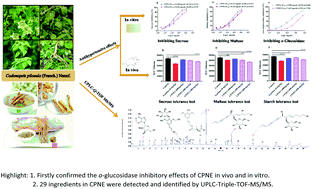Hypoglycemic activity of Codonopsis pilosula (Franch.) Nannf. in vitro and in vivo and its chemical composition identification by UPLC-Triple-TOF-MS/MS
Abstract
Codonopsis pilosula (Franch.) Nannf. (CPN), mainly planted in the northwest region, is a traditional Chinese medicine/good health food for nourishing qi and promoting blood circulation. This study firstly evaluated the inhibitory effects of the CPN extraction (CPNE) on α-glucosidase in vitro and in vivo, and tentatively confirmed its chemical ingredients by employing UHPLC-Triple-TOF-MS/MS. The CPNE had strong inhibitory activities against mammalian α-glucosidase (sucrase and maltase) and yeast α-glycosidase with semi-inhibitory concentrations (IC50) of 0.241 mg mL−1, 0.326 mg mL−1 and 1.167 mg mL−1, respectively. In addition, the CPNE could significantly decrease the postprandial blood glucose (PBG) levels in the sucrose/maltose/starch tolerance assays of diabetic mice. Furthermore, a total of 29 compounds, including 3 alkaloids, 13 phenolic acids, 8 alcohol glycosides and 5 alkynosides, were assigned based on comparison with the standards and references, as well as the analysis of main fragments. These results demonstrated that CPN could be used as an adjuvant therapy or dietary supplements to effectively control the occurrence and development of diabetes.



 Please wait while we load your content...
Please wait while we load your content...